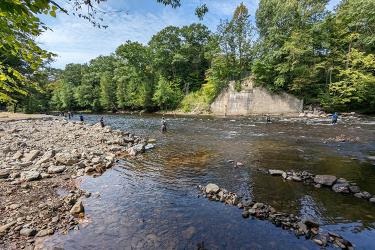Where did you grow up?
I grew up in Lakewood, New Jersey, about 20 minutes away from the Jersey Shore. Growing up close to the shore, I had a passion for learning about the marine environment. The fascinating diversity of species I saw while watching National Geographic and Discovery Channel documentaries about life underwater helped me decide to pursue a career in this field. I appreciated that some marine species taste amazing as well. I knew that I wanted to be a marine biologist during my junior year of high school.
Where did you go to school and in what subject did you get your degree(s)?
I applied to any college I knew of within an 8-hour car ride that offered an undergraduate marine sciences major. I was happy to attend the University of Connecticut, including the Avery Point Marine Sciences campus. As an undergraduate, reading articles about NOAA and learning more about what NOAA does sparked my life goal of one day working for this agency.
How did you come to work at the science center?
My first job out of college was as a fisheries observer with the Northeast Fisheries Observer Program. Fisheries observers are professionally trained biological scientists who collect catch data onboard commercial fishing vessels for NOAA Fisheries. This data is used for many things, including fisheries stock assessments and ecosystems studies. It was a great opportunity for someone who dreamed of working for NOAA.
After about a year and a half of observing, I applied and was selected to become a Fisheries Observer Instructor. I was ecstatic about this position because it was an opportunity to be a role model for observer trainees, just as I viewed my instructors when I was a trainee in the program. In this role, I brought my experiences and lessons learned from deploying on fishing vessels from Massachusetts to North Carolina as a Person of Color into the training room.
My job wasn’t just to make sure the trainees knew how to identify fish. It was also to support and validate those voices who felt isolated—those voices who questioned, “is this the right field for me because nobody looks like me?”
As someone who has been there and has seen a lot of things out at sea, I set out to create a supportive community. I feel that I made progress toward these ambitions because I received this anonymous feedback from a trainee: “It was helpful seeing a mentor of color. Walking into training I didn't feel too comfortable being the only new Person of Color. Isaiah helped with my transition in a way that goes beyond words.”
What do you do at the science center?
I am proud to work for NOAA Fisheries as a biological science technician at the Milford Laboratory, a world leader in aquaculture science. I’m involved in many research projects including projects focused on improving oyster restoration and understanding the effects of ocean acidification on shellfish.
I am also co-chair of an employee resource group called Celebrating All Races and Ethnicities (CARE). I help run meetings, plan special events, and—most importantly—have fun.
What do you like most about your position?
I love learning about the projects that I’m involved with and being able to work with such passionate researchers. The staff here at the Milford Lab encourage a learning environment where I can ask hundreds of questions and get hundreds of answers. I also like the strong sentiment of collaboration and support here at the lab.
What are some of your hobbies?
In my free time, I take care of a 55-gallon aquarium that is home to schools of tetras and Cucumber, my 12-inch algae eater. I also like to travel. I have collected more than 20 antique masks ranging in origin from Latin America, Africa, and the Caribbean.
When I am not talking about fish or shellfish with my fiancée, I am talking about my favorite sports team: the Philadelphia Eagles. Even though I grew up in New Jersey’s New York Giants territory and then deep into New England Patriots territory, I still wear my Eagles gear all year round.
What does Black History Month mean to you?
Black History Month has always meant a lot to me. Growing up, I learned so much about the contributions African Americans have made to U.S. history. These contributions are particularly notable considering the conditions in which they were able to succeed, and they are not always mentioned in school history books.
I was brought up in the St. Thomas Episcopalian Church, which started in 1907 as an African American parish. Every single year we recognized and celebrated those whose legacies serve to celebrate Black History Month. This includes the legacy of our church members like the late WWII veteran and Army Radar Systems Engineer Mr. Harold N. Tate. His daughter was the late Dr. Claudia C. Tate, Professor of English and African American Studies at Princeton University. Mr. Tate would talk with me every single Sunday through my high school years, sharing incredible stories about his children. He told me to never forget that if I worked hard on my grades in school, the sky's the limit with my education. I treasure those memories and all the people we would highlight during Black History Month at my church. It helped me learn about what People of Color can achieve and understand my own potential.







